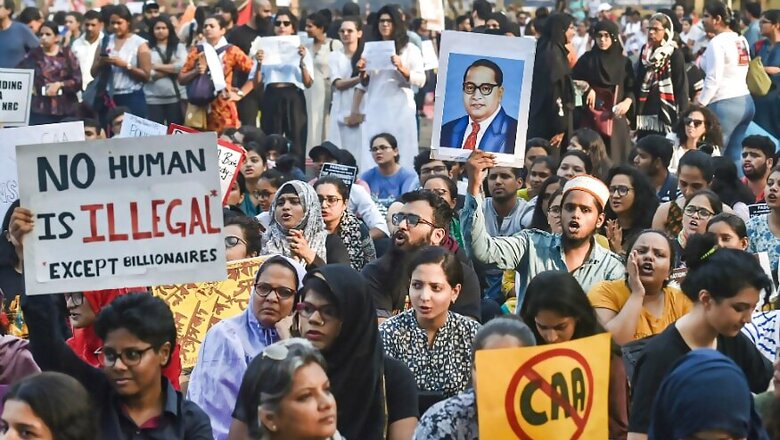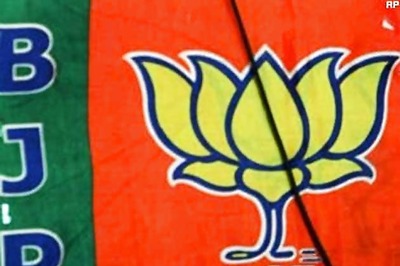
views
The formulation of National Register of Citizens (NRC) and Citizenship Amendment Act (CAA) by the central government has engendered nationwide protests. People from discrete social, economic, political and regional backgrounds have come onto the streets to register their disapproval on the Act.
They believe the CAA is communal in nature as it confers citizenship on the basis of religion. They also believe that questioning citizenship and seeking of proof will disenfranchise millions of poor irrespective of religion and that the initiative of the government is an attack on the basic tenets and individual constitutional rights.
The ongoing movement of resistance against the NRC and CAA is seen as one of the biggest mass movements, after the discontent against emergency, in post-independent India. The movement is remarkable in terms of its mode of protests, language of resistance and symbols. Another distinct aspect of these protests is the voice of millennials and of those who were born post-liberalised India connected through the unifying thread of right to protest.
The most conspicuous symbol of this ongoing resistance is the portrait of Dr BR Ambedkar, father of the Indian Constitution, held high, waved, as an enduring image of resistance by the protestors. Visual imagery splashed across through photos and videos of protestors carrying Ambedkar’s portrait in large numbers on streets is a major departure from India’s conventional history of political resistance.
Ambedkar was hitherto a focal point in the resistance movements and mobilisations of the Dalits and oppressed communities. However, his image and thoughts have now transcended the boundaries of stereotyped caste and communal propositions. It signals the beginning of a new political and social awakening in the country where Ambedkar emerges as the focal rallying point of resistance to the oppression unleashed by very people whom the nation has voted to power. This was further accentuated by the imageries and visuals of ruthless police trying to crush the resistance with senseless impunity.
Like all enduring images of resistance movements in the country, at least two images are going to stay in the public memory symbolising NRC-CAA movement. First one is of Ramachandra Guha, a well-known scholar and historian on Mahatma Gandhi, holding Ambedkar’s portrait, not Gandhi’s, during his protest against the Act at Bengaluru, talking to the media, being whisked away by the police. The other is of Chandrashekhar Azad, chief of Bhim Army, protesting at Jama Masjid holding a copy of the Constitution. Both the images have become epic moments of the protests against CAA and NRC.
The portrait of Ambedkar is now being widely symbolised as an antidote to anti-people approach and actions of the governments. His ideas and thoughts are often invoked in the speeches given during protest marches, along with slogans that uphold the values and principles enshrined in the constitution.
Slogans of Jai Bhim are also being echoed on the streets. The most noticeable group among the protestors is of the millennials, who are seen at protest sites in large numbers chanting Ambedkar’s slogans and advocating constitutional principles. They are often seen celebrating Ambedkar and Constitution through their posters, slogans, banners. Ambedkar is ubiquitous now.
There are several reasons for this new phenomenon of universal resurging and acceptance of Ambedkar on the landscape of political resistance in India. The push factor behind the acceptability of Ambedkar as a figure of resistance is the omnipresence of a tenacious Dalit-Bahujan movement in the post independent India. It has been instrumental in bringing Ambedkar’s thoughts and ideas into India’s public discourse.
The emergence of Dalit movements across India, including Dalit Panthers Movement of 1970s, emergence of political parties based on Dalit-Bahujan identity during 1980s and enactment of Mandal Commission recommendations, played a pivotal role in bringing Ambedkar’s ideas and thoughts into the social and political realm. The pull factor behind the unprecedented popularity and acceptability of Ambedkar is his invaluable contribution to the making of constitution. People are now finding the possible applicability and validity of the constitutional principles put forward by Ambedkar for the problems that they are facing today.
In Ambedkar’s words: “If Hindu Raj does become a fact, it will, no doubt, be the greatest calamity for this country. No matter what the Hindus say, Hinduism is a menace to liberty, equality and fraternity. On that account it is incompatible with democracy…” from his 1946 Pakistan or the Partition of India, seem to be like a warning valid even for today.
His consistent challenge to the Hindu religion on the tenets of democratic principles and basic tenets of liberty, equality and fraternity, and its fervent propagation by democratic forces lead by Dalits in the country, have rung the bells now. He warned and appealed the people of India to realise and escape from the menace perpetuated by the majority Hindutva forces by replacing the social morality with the constitutional morality.
Now, people are the direct threat of what Ambedkar was then fighting against and they are realising in hindsight that Ambedkar was true in his prognosis. He was completely aware of the jeopardy of the tyranny of majority in a democracy and he clearly identified the communal majority in the Indian context.
Ambedkar emerges as a strong bulwark against the Hindutva forces. His denouncement of Hindu Raj and fascism validates the people’s gesture of making him a rightful icon in these protests. His image acquires exceptional legitimacy in NRC-CAA protests in Uttar Pradesh as in faraway Amaravati, where upper caste farmers hold onto Ambedkar’s portraits, seeking to save the fledging capital city of residual Andhra Pradesh.
The emergence of Ambedkar and the slogan Jai Bhim are a medium for the protesting people to communicate their belief in the law of the land and constitutional methods to reassure their rights from the state. There is a sense of impunity among the protesters when they hold the constitution or the portrait of Ambedkar. People believe that holding Ambedkar’s portrait helps reduce the antagonism of the state machinery. Moreover, Ambedkar’s emphasis on rights of the deprived is now gaining more acceptability as the people of this very country are at the verge of a possible deprival of their own rights.
The antidote to divisive politics lies in the comprehensive reading, understanding and implementation of ideas and thoughts of Ambedkar. It will eventually lead India into a new light of Prabhudh Bharat where everyone lives as thinking beings based on maîtree, as Ambedkar put it, and equal respect intertwined with the principle of constitutional morality.
The author holds a Ph.D in International Studies from JNU, New Delhi. She taught Political Science in Delhi University’s Bharati College.



















Comments
0 comment